A feature of Kazakh folk art is keste, traditional hand-made embroidery with multi-coloured threads using a needle (Ine) and fine sila-hook (bіz / kest bіz / Ilmek) on the fabric. The semantics of the word keste (to embroider, make a drawing, kesteleu draw a pattern, etc.) speaks about the feeling of tact and rhythm in colour, a characteristic of Kazakh embroidery. The practice of embroidery, an item of deep antiquity, was part of magical and ritual actions, when there was an urgent need to “endow” clothing and household items with beauty, recognition, status, also protective functions. Known far beyond the borders of the country, archaeological finds on the territory of Kazakhstan testify to the authenticity of this type of art. Vivid evidence of this is the organic matter, which were found in the Berel mounds. The mound is located in East Kazakhstan, dating back to the fourth–third centuries BC. (the excavation of Z.Samashev: Baıpakov K.M., Samashev Z.S., Toleýbaev A.T., 2006).
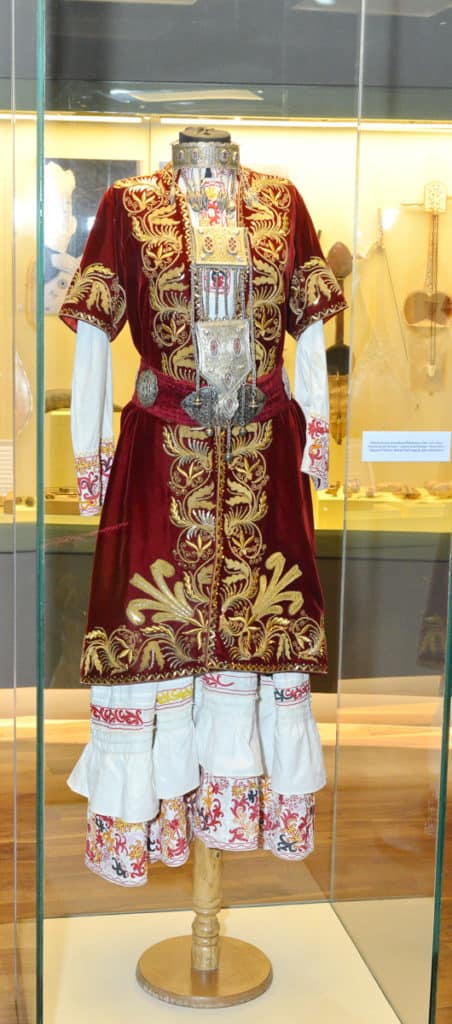
A samples of gold sewing on beshpent and chain embroidery on the dress. Costume of Fatima, wife of Khan Zhangir. XIX century
The high point of Kazakh embroidery is shown in wall carpets (tuskiiz/tusleste), which are the talismans of the house; unique patterns of quilted cord floor carpets (syrmaq and tekemet); ceremonial and festive men’s and women’s clothing (men’s robes, shapan, dresses koilek, hinged skirts beldemshe, sleeveless beshpent / qamzol); headgear, kimeshek, headscarves oramal; men’s shoes saptama / shonqayma /, women’s shoes koksauyr etik, masi; interior items: tablecloths dastarqan, canvas bags qorzhyn and many other products.
There are about forty complex and simple types of Kazakh embroidery. In addition to technical characteristics, in their names, there is often a mention of any animal, plant, fragments of their parts, because they can cause such associations. There are even names where embroidery is likened to the tracks of animals – “tyshqan izi”, “qus izi”. Also, known embroidery differing in regional characteristics (e.g., “qyzay keste”, from the name of the progenitor of the genus, the Kazakhs from the Ile-Kazakh district, XUAR). Floral elements in the form of a blooming tulip, stylized motifs of floral ornament adorn women’s headdresses (kimeshek, shylauysh, and tobeldirik, details of the dress). They are also widely used in the decoration of wall carpets, pillowcases for pillows and other products.
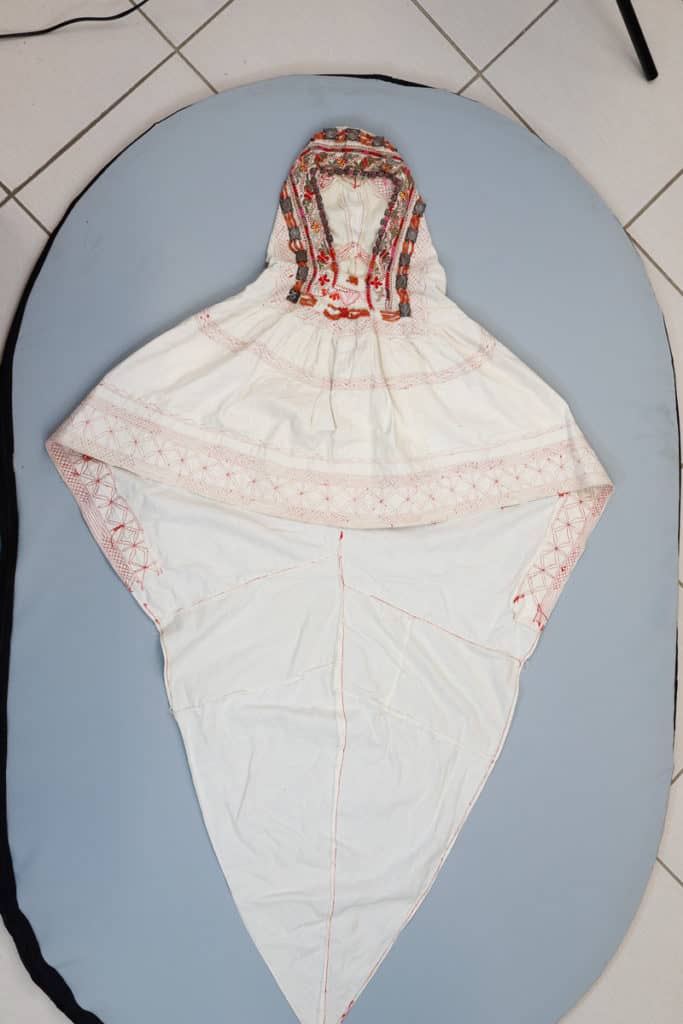
Kimeshek – women’s headdress embroidered with corals, metal embroidered plaques. In the middle of the 20th century
Stitching together the parts of wall / floor carpets or attaching parts of clothing defined the name of the technician: “kosu”, “kabu”, from the frequency of stitches going one after another – “syru”, sorting through the threads teru and many other embroidery techniques.
The most common types of embroidery techniques include bіz keste, the technique of chain stitch, created with the help of a thin sewed hook. Decorative seams are made with the help of a hoop resembling a large drum, a tambour. In the Kazakh “family” of embroidery, it is also widely used and is called shynzhyr (Shanyraq, 1989), literally a chain of rings.
Techniques of fixing the frequency, shape and stitch length are distinguished in a complex: tіzbek tіgіs, shyrash tіgіs, shynzhyr, shym keste (glued dense without gaps seam), qigash, albyr keste (two-row wide seam), names and varieties of tambour, embroidered needle; oraipek / oraipa is a kind of gummer. It makes a pattern up to eight mm wide. It includes kebeke a seam similar to embroidery on the canvas; zhorme, zhormeme, aiqas tigis, cross-stitch; kerege bas tigis – a seam resembling the place of attachment of a lattice of a yurt and many others. The technique of smoothing tygys tigis is divided into baspa, with attachment, bastyrma, without the attachment and simple, shyralzhyn. The smooth seam of bedel-keste with the underlay forms a convex relief. Upper sandstone zhormeu, where the thread forms a zigzag weave, zhormeu baspa wool embroidery on felt and other fabrics.
Materials for embroidery are woollen and cotton threads. The thickness of the threads depends on the intended technique. Due to the high cost of material silk, gold and silver threads were used for the decoration of ceremonial festive clothing, wall carpets, bedspreads and other products. In addition to the threads, stripes of braids were also used; various sewn metal plaques / ornaments; the types of beads, pearl, coral, as well as beads, glass beads, sequins, strung on strong polyester yarn, gave a peculiar name to embroidery using beads, marzhandau / marzhandy keste; gold threads, altyndap tigu; gimp (a kind of cord of metallic thread), zerleu; oqa (braid, sheathed in gold or silver) and others. These techniques are often used in combination.
The variety of embroidery evolved from the structure of woven cloths. The main ones are homespun cloths, types of felt (knitted / felted woollen fibers), including thin felt (made of wool / down), treated skins of various animals (domestic and wild), suede (velour, derived from the inner sides of the dense skins of livestock, careful polishing creates a low thick pile), as well as a canvas of durable fibrous dogbane (perennial herbaceous plant) with the addition of goat down or camel hair.
The items of clothing presented at the museum also used imported fabrics, such as the supplest embroidery, colourful in structure and wear-resistant. The most exquisite embroidered items made of red and black velvet, barqyt (fabric with a cut pile, where four pairs of interlaced silk, woollen threads form the upper and lower bases, and the fifth – pile), on fabrics with a long pile, in common language blues or pulyus mats. This is a variety of velvet with a long nap (ornamental embroidery on them is less frequent, it is used along the border or in the centre of the wall carpets). Silk cloths and brocade are quite rare in use (soft fabric of silkworm cocoon), more often used more simple cotton, cloth (woollen or with the addition of cotton), chintz (cotton fabric with printed pattern or dyed) sometimes velveteen (fabric made of cotton with a nap and longitudinal cuts). The velveteen is convenient for counting, as the width of the hem is taken as a cage, etc.
Like fabrics, a large number of threads are imported. Most often, the skilled workers used ready-dyed cotton, silk coloured threads. Some of them received dye from plants, including madder, henna (bright orange), rhubarb (a yellow colour), from pine bark (red-brown). They also dye hides using onion peel (brown or shades of golden-ochre colour), fruit extracts and berries: cherries – pink shades, currants – maroon (usually cold in sound). Natural dyes were fixed with alum, ashutas/ashudas.
Direct analogies to the Kazakh items, embroidered with multi-coloured woollen threads, are found in the materials of the unique mounds of Berel with permafrost. The exposition of the Gold Hall of the National Museum includes a saddle appliqué embroidered with a chain stitch with multi-colored wool thread. It depicts a winged horse in a horned mask (according to Z. Samashev). The width and stitch length of about 2 × 2.5 mm, which indicates about thin twist of wool fibers. The colour set varies between black, ocher-brown and brown, due to the antiquity of the items, the density of the colour tone is lighter.
No less interesting, embroidery techniques earlier in time (II millennium BC, Andronovo culture) are exhibited in the hall of ancient and medieval history. In particular, on the clothing of the Andronovo woman (reconstruction according to K.Akishev), an example of embroidery technique is presented, widely used on clothing and everyday life of the Kazakhs. Thus, embroidered geometric patterns descend along the hem of the dress with a frieze ribbon. It meanders, broken lines at right angles, triangles and rhombuses, are marked between the rows of a ticker from the lines running one after the other, like “Christmas tree”.
The techniques tygyz tigis are applied for smoothing, one- and / or double-sided seam, in which the stitches lie to each other in parallel rows, called shyralzhyn. The second look, folded in a row one after another with parallel straight stitches that are similar to each other is qabyrga tigis, and the bottom line is embroidered diagonally with the tandai technique (reminiscent of a sky pattern) (Qazaq halqynyń ulttyq kıіmderі, 2011). The above-mentioned types of embroidery are used by masters of the western regions of the republic, in finishing of women’s headwear oramal, dresses koilek, in household items, in the decoration of home textile dastarqan.

A samples of gold sewing on beshpent and chain embroidery on the dress. Costume of Fatima, wife of Khan Zhangir. XIX century
A sensitive attitude to the use of expensive materials, such as gold, silver, led to the creation of exquisite seams that are rich in structure and processing (cloth, soft suede, felt, etc.) fabrics of dark and red color. The Kazakh kesteshi is skilled in gold embroidery altyndap tigu / zerlep. Here are also distinguishable several types. Embroidery is embroidered with laces oqa, silver galloon and cord seams along the edge, often used in the top parade and festive clothes, on hats and interior objects. Gilded threads were sometimes replaced by metallised ones, such as spiral gimp (in Italian canutillo) or Lurex, this technique was called zerleu.
For a headdress aq qalpaq are used white silk threads are used in combination with silver (gold) threads and a lace tulle. On the edges, cord embroidery shyrash (chyrash) is used. According to the master, depending on the purpose and requirements of the customer, the threads may vary in color and quality.
In kimeshek the rule of using embroidery “tandai tigis” is observed on the front cut of zhaqtary, iegi. (pic. 3). According to the information of the Kazakh women of Mongolia, the age and status of a woman (young, married, widow, etc.) is still important for decorating hats, in particular kimeshek. The colour and frequency of the embroidery pattern, the use of materials (coral beads, gold threads, metal plaques, pozument) depend on this (pic. 4. Fragment)
The decoration of golden threads of items from soft fabrics of Kazakh craftswomen demonstrates a direct continuity of the traditions of the past, as in the decoration of clothing, consisting of gold plates and figured plaques, and in colour. This is evidenced by materials from graves found on the territory of Kazakhstan. Among them, the phenomenal “Golden Man” of the Issyk mound (Saki, Zhetysu, IV – III centuries BC, excavations by K. Akishev), artifacts from Baygetobe (Saki, East Kazakhstan, VIII-VII centuries BC, excavations by A. Toleubaev), Taldy- 2 (Saki, Saryarka, Central Kazakhstan, 6th – 5th centuries BC, excavations by A. Beysenov), Taksai-1 (Savromats, Western Kazakhstan, 6th – 5th centuries BC, excavations by M. Sdykov , Y. Lukpanova), Araltobe mound (Sarmatians, Western Kazakhstan, 3rd century AD, excavations by Z. Samashev) and other unique finds from the mounds.\
The exhibits of the History Hall, in particular, the man’s headdress of red velvet muraq (Kyzylorda, XVIII-XIX centuries), shapan of Tole bi (the South Kazakhstan, XVIII centuries, renovation) demonstrate a high culture of embroidery with gold and silver threads. To used types are included above mentioned techniques: shyralzhyn (tight without gaps seam); tandai (stalked, in which the thread forms a zigzag weave); and bedel keste (the technique of smoothing with the use of lining, which gives a convex relief embroidery).
The art of national embroidery is most fully and vividly revealed in wall and floor carpets. Individual masters, based on the composition and ornament of wall carpets, embroider bedspreads, partially modified on the bottom board, having a border like in tekemet or pile carpets. These items are exposed on the vitrines of the Ethnography hall.
In terms of scale, wall and floor felt carpets standout, including tekemet, syrmaq, tuskiiz, and tuskeste. Most of the Kazakh carpets, used for heating and noise insulation purposes, are decorated with black and white and colored woolen threads. Here, zhormeu baspa, zhara tіgіs are used. Often embroidered with woolen threads (due to rapid wear) on a pre-rolled felt. As noted above, in tekemet, syrmaq, felt bags (pic. 7) often used the technique syru, literally stitching, sew with cord threads. An example is the camel wool twisted rope shuda, which gives strength and a clear contrast pattern on the canvas.
The creation of a single composition of circles, vortex rosettes, crosses helped the knowledge of symmetry and counting. With the help of various embroidery techniques, the chain carpets are skillfully combined in the wall carpets, which serves as the outline of the pattern, filled with a satin stitch in the attachment (baspa) or a simple satin (shyralzhyn). These techniques are used in combination. There are simpler stitches for auxiliary technical operations, for example, sewing large stitches over the hem. Techniques ayqas tigіs are widespread (Qazaqtyń etnografııalyq kategorııalar…, 2011). Embroidery has a pattern of a lattice where the threads go overlap. A needle with a large eye is used, where a thread folded several times is inserted.
The most distinctive and colourful are wall (more often above the bed) carpets (tuskeste), which are mandatory in the composition of the bride’s dowry items. A sample example of thin embroidery is exhibit item No. 1, a wall ornamental carpet. It differs from other similar items by embroidery throughout the canvas. Applied techniques include looped chain stitch; it follows the outline of the pattern and is partially filled in different colors. The pattern of vegetative ornament favoured by craftswomen prevails; it is composed of shoots, opening buds, climbing stems, and other interpretations that set a colourful, emotional tone to space.
The composition of embroidered Kazakh wall carpets is reduced to the U-shaped form. It is composed of wide strips (from the edge to the centre) of plush, satin, cotton fabric, etc. The main and beloved technique of embroidery of tuskeste (literally means wall embroidery) is chain stitch tizbek. It’s been made from special prepared metal with fine crochet hook ilmek (ilme) (the technology of creating a needle with a wooden handle about 10 cm long, is reduced to heating the needle tip, hammering it on the anvil, reheating and cutting the needle, followed by polishing) (Bekkýlova A., Mýhamedjan Z., 2012).
Widely used wall-hanging carpets tuskeste using various embroidery techniques are distinguished by the use of coral and pearl beads (hard-to-reach, expensive materials, a sign of prosperity). The beads, strung on threads and embossed on the ornamented surface of the canvas, created a convex, three-dimensional pattern. These types of vehicles are called marjandau or monshaktap kesteleu.
To create such products, a wooden machine kergish (an elongated rectangular or round, the shape depended on the choice of a craftswoman) is used to keep the fabric in a stretched state and protect it from deformation. The Kazakh kergish are the wooden rods connected among themselves. The fabric was sewn right on the frame of twigs or stretched on the threads going at a right angle.
The unique embroidered patterns include the top men’s and women’s clothing made of fine wool-free pelt (qulyn jargaq), from foal skin, men’s trousers (jargaq shalbar), from sheepskin. Masters embroidered on such canvases with the help of thin needles with a triangular tip. For embroidery of these products involved variations of chain stitch.
A sample of inimitable embroidery with the subtlest stitches, like oraipek/oraipa, “Tyshkan іzі”, albur keste, is presented in a double skirt – Beldemshe.
The expressiveness of the artistic language was manifested in the Kazakh embroidery through the ornamental forms of cosmogonic, geometric, plant and zoomorphic patterns. The most recognisable is the ornament in the form of a circle (tabaksha) found on clothes, in particular, men’s’ shapans (Embroidery with tabaksha chain pattern), wall hangings tuskiiz/tuskeste.
Sacral motives were composed from triangles, rhombuses, wavy lines, stylised motives of flying birds, opening buds, etc. Patterns and ornaments symbolising the richness of the plant and animal world were embroidered with the message of well-being and prosperity to the whole family. Samples of canons and principles of compositional design of the ornament were selected in the system created by each craftswoman separately. The purpose and use of patterns, built into the ornamental component, indicate a high level of skills of embroiderers.
Many unique embroidery patterns have not been preserved, the exact name and meaning are forgotten. But despite this fact, the chances of restoring them are multiplied thanks to the museum collection exhibits, which were collected during archeological excavations and ethnographic expeditions.
Looking at the items on display at the National Museum, it can be noted that the Kazakh people from ancient times created products made of soft materials with embroidery: from the smallest textile items to large carpet lengths and widths of several meters. Despite the steady canonicity of the compositions, a large role is given to improvisation. In view of this, virtually every embroidery is unique.
Today, masters continue the age-old traditions of embroidery art. A wide variety of embroidery techniques can be seen in yurts during the celebration of the Day of Nature Renovation, Nauryz. The above-mentioned Kazakh embroidery techniques, knowledge and skills are bequeathed to the families of masters through inheritance, like from parents to children, or through various training workshops and master classes in educational centers and in other ways.
The leading kesteshi of our republic are A. Saginaeva, G. Balgabaeva, M. Mashai – representatives of Western Kazakhstan, G. Kozhamzharova, S. Azkhan – East Kazakhstan region, S. Seytmagambetova from Astana, M. Zeinelkhan, K. Kusiman, B. Zeinelkhan, O. Rystan, G. Omirzak, A. Abdubaitova – represent Almaty, sisters Shermuhamedov, family Beyisbekov, J. Beysenova – embroiderers of the South Kazastan region, as well as many other masters in different regions.
References
Baıpakov K.M., Samashev Z.S., Toleýbaev A.T. Arheologııa Kazahstana. – Almaty: «Óner», 2006. –256 s.
Bekkýlova A., Mýhamedjan Z. Keste. Vyshıvka. Qolónershіlerge arnalǵan oqý quraly. Posobıe dlıa remeslennıkov. – Almaty, 2012. – 82 s.
Qazaqstan Respýblıkasy Ulttyq mýzeıіnіń fotoalbom kіtaby. Knıga-fotoalbom Natsıonalnogo mýzeıa Respýblıkı Kazahstan. The book–photo album of the National Museum of the Republic of Kazakhstan / Qurast.: A. Nurazhan, Z. Samashev, K. Ahmetjan, V. Zaıbert, N. Alımbaı, K. Altynbekov ı dr. – Almaty: Taý Qaınar, 2014. – 248 b., qazaqsha, oryssha, aǵylshynsha.
Qazaq halqynyń ulttyq kıіmderі. Natsıonalnaıa odejda kazahskogo naroda. National clothes of Kazakh people / Qurast.: B. Hınaıat, A. Sýjıkova. –Almaty: Almatykіtap baspasy, 2011. – 384 bet, sýrettі.
Qazaqtyń etnografııalyq kategorııalar, uǵymdar men ataýlarynyń dástúrlі júıesі. Ǵylymı redaktor jáne joba jetekshіsі N. Álіmbaı. Entsıklopedııa. – Almaty: DPS, 2011. 1 tom. A-D.
Shanyraq. Qysqasha úı-turmysy entsıklopedııasy / Bas redaktor R.N. Nurǵalıev. – Almaty, 1989. – 568 b., 1106 sýret
Author

Raushan Kargabekova is an art critic with a Masters degree. She is the senior teacher at the Kazakh national University of arts (city of Nur-Sultan), the area of researches includes studying and promoting of traditional and modern applied art of Kazakhs, also the development of workmanship in the republic. She is also the senior teacher at the Kazakh national University of arts (city of Nur-Sultan) and honorary member Zhyuri of a republican competition of handicraftsmen “Sheber”.She is the author of articles on applied art of Kazakhstan for the Encyclopedia of the World Craft Council -APR /Central Asia.


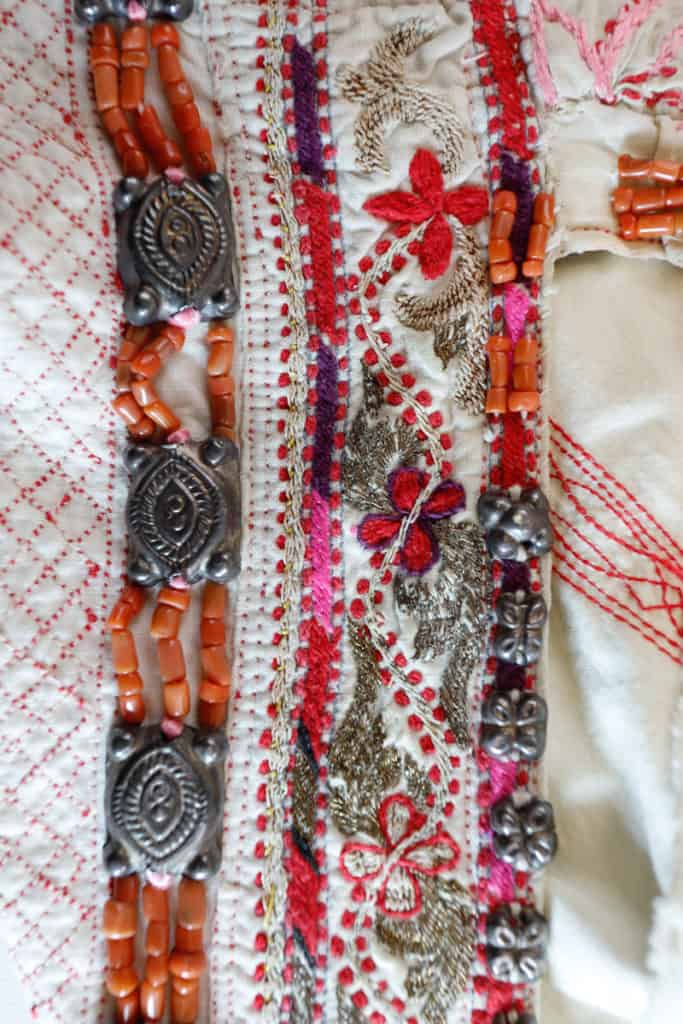
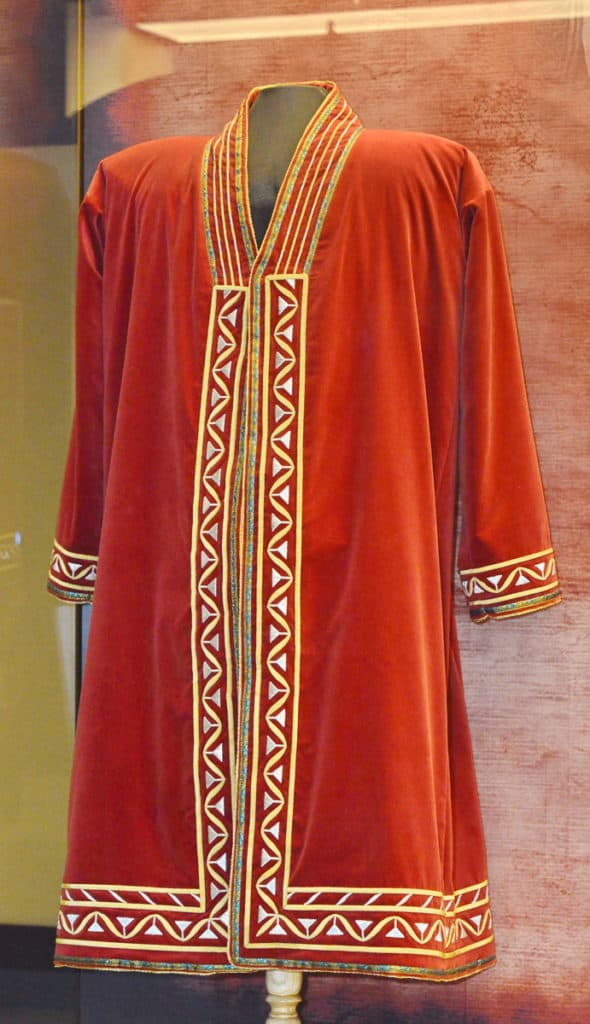
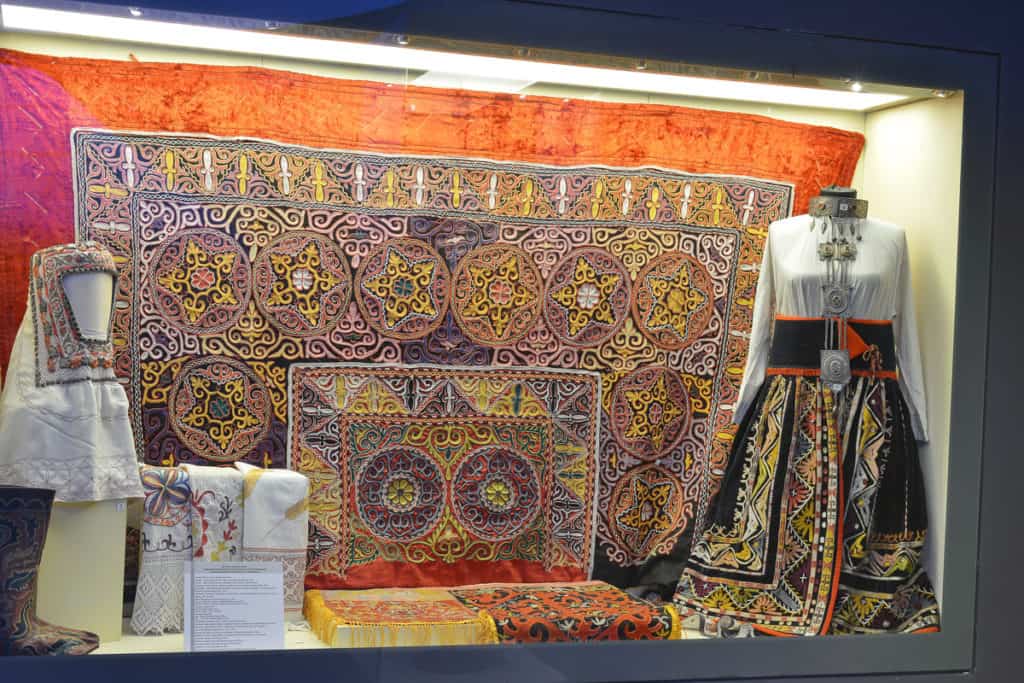
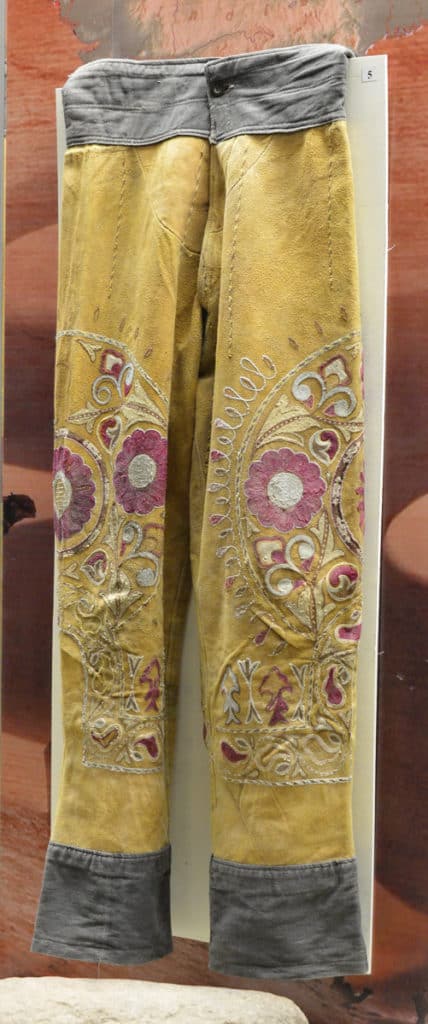
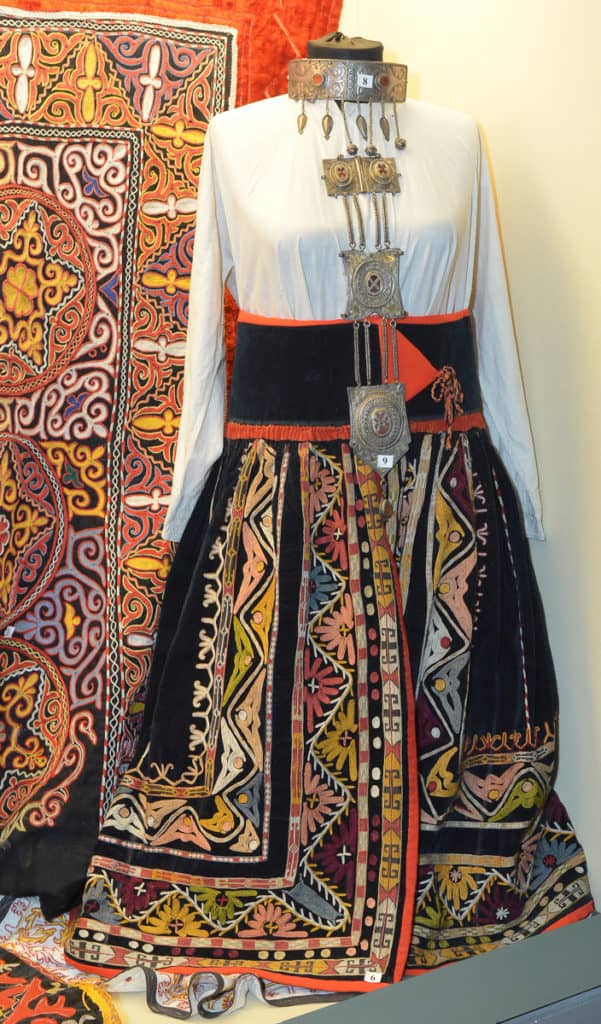


Comments
So much of great interest to read here! Thank you.